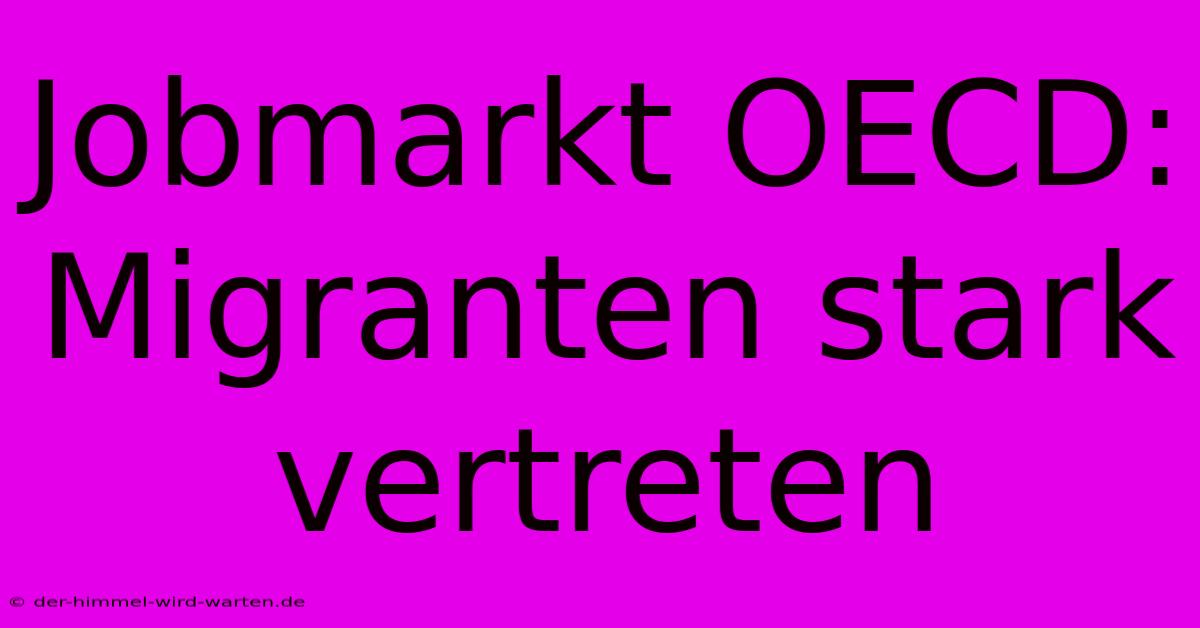Jobmarkt OECD: Migranten Stark Vertreten

Discover more detailed and exciting information on our website. Click the link below to start your adventure: Visit Best Website Jobmarkt OECD: Migranten Stark Vertreten. Don't miss out!
Table of Contents
Jobmarkt OECD: Migranten stark vertreten – Ein Blick auf die Zahlen und Herausforderungen
Hey Leute,
let's talk about something super relevant: the OECD job market and the strong presence of migrants within it. I've been researching this topic for a while now, and honestly, it's way more complex than I initially thought. There's a lot of data to sift through, and frankly, I've made a few mistakes along the way trying to understand it all.
Migranten im OECD-Raum: Fakten und Zahlen
The OECD, or Organisation for Economic Co-operation and Development, includes a bunch of wealthy countries, right? Think Germany, the US, Canada – the usual suspects. And what's striking is the significant contribution of migrants to their labor forces. We're not just talking about a small percentage; it's a substantial part of the workforce across many sectors.
I initially tried to just pull numbers from random websites, but that was a total disaster. The data is scattered everywhere. I learned the hard way that you need to go straight to the OECD’s website for reliable statistics. They have detailed reports and databases that are amazing, but you gotta be patient, it's not exactly a quick read.
One thing that really stood out to me was the variation between OECD countries. While some show a huge reliance on migrant workers (looking at you, Germany!), others have significantly lower percentages. This isn't just about immigration policies, either; it's about economic needs, demographics, and a whole host of other factors. It's a really complex puzzle.
Sektorale Unterschiede: Wo arbeiten Migranten?
Another thing I found fascinating was the distribution of migrant workers across different sectors. You'd think it'd be evenly spread, but it's not. Certain industries rely heavily on migrant labor—think healthcare, hospitality, and agriculture. These often involve jobs that locals might not be as interested in, or jobs that require specific skills often possessed by migrants. It's a bit of a chicken-and-egg situation.
Herausforderungen und Chancen
Now, let’s get real. There are challenges, of course. Integration into the workforce isn't always smooth. Language barriers, recognition of foreign qualifications, and even prejudice can hinder migrant workers' success. I saw a study once that highlighted the wage gap between migrant and native-born workers, which was pretty disheartening.
But it's not all doom and gloom. Migrant workers bring skills, talent, and often fill labor shortages, which is essential for many OECD economies. They contribute significantly to economic growth and diversity. The potential is huge.
Was können wir tun?
So, what can we do to improve the situation? Well, for starters, better integration programs are crucial. This means focusing on language training, recognizing foreign qualifications more effectively, and actively combating discrimination. We also need to address the specific challenges faced by different migrant groups – it’s not a one-size-fits-all solution.
Plus, policies that promote fair wages and working conditions for all workers, regardless of origin, are vital. We're talking about human rights, people! It’s not just about economics; it's about creating a just and equitable society.
Fazit: Eine komplexe, aber wichtige Diskussion
The OECD job market and its reliance on migrant workers is a complex issue with many angles to consider. There are hurdles to overcome, absolutely. But ignoring the significant contributions of migrants would be foolish. It's a conversation that needs to continue, with everyone involved striving for better integration and a more inclusive labor market. Let's keep talking about this, people! I'm still learning, and I'm sure there's much more to uncover.
What are your thoughts? Let me know in the comments below. Let’s help each other learn and understand this important topic better!

Thank you for visiting our website wich cover about Jobmarkt OECD: Migranten Stark Vertreten. We hope the information provided has been useful to you. Feel free to contact us if you have any questions or need further assistance. See you next time and dont miss to bookmark.
Featured Posts
-
Kaernten Wetter And News 21 11 2024
Nov 22, 2024
-
Handelsimpulse Madagaskar Und Die Zlecaf
Nov 22, 2024
-
Neue Uber Angebote In Der Schweiz
Nov 22, 2024
-
1 25 Milliarden E Vbls Neuer Nachhaltigkeitsfonds
Nov 22, 2024
-
X Ai Grok Bewertung Erreicht 50 Milliarden
Nov 22, 2024
